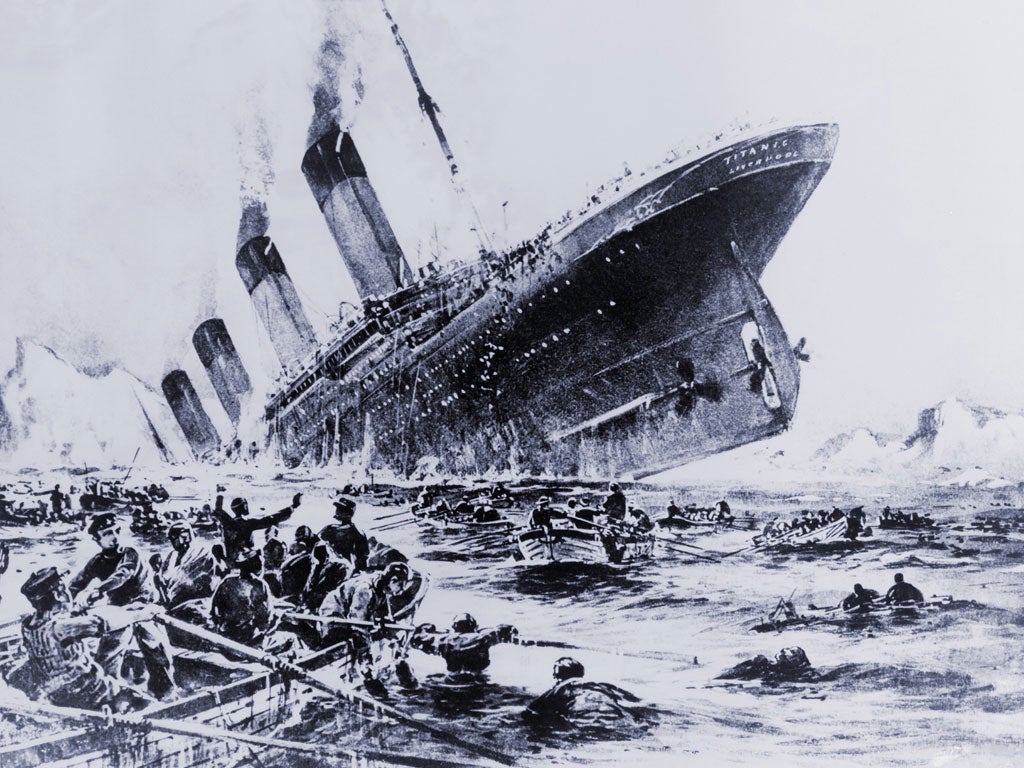
Your support helps us to tell the story
From reproductive rights to climate change to Big Tech, The Independent is on the ground when the story is developing. Whether it's investigating the financials of Elon Musk's pro-Trump PAC or producing our latest documentary, 'The A Word', which shines a light on the American women fighting for reproductive rights, we know how important it is to parse out the facts from the messaging.
At such a critical moment in US history, we need reporters on the ground. Your donation allows us to keep sending journalists to speak to both sides of the story.
The Independent is trusted by Americans across the entire political spectrum. And unlike many other quality news outlets, we choose not to lock Americans out of our reporting and analysis with paywalls. We believe quality journalism should be available to everyone, paid for by those who can afford it.
Your support makes all the difference.As the subject for a book, surely, the Titanic is well and truly sunk. An ocean of print has spilled over the great maritime disaster and in its centenary year, a further flood must be impending. Can there be anything more to say? The answer, as Richard Davenport-Hines shows in this rich, incisive and poignant study, is a resounding yes. He treats the doomed liner as a container ship, its separate compartments holding a cross-section of European and American society at a time when inequalities had never been more flagrant. The wealthiest man on board was Colonel Jack Astor, who was carrying $4,000 in sodden notes when his body was found; among the poorest was a 19-year-old Greek farm worker called Vassilios Katavelas, who had ten cents and a train ticket to Milwaukee.
Davenport-Hines inveighs against the arrogance of the plutocrats in first class, arguing that the brutal exercise of money power defined the age of the Titanic. The ship was a floating Ritz where they (and their card-sharping parasites) were concerned. The public rooms were palatial. The suites had open fires, picture windows, beds rather than berths and decoration in styles ranging from Regency to Italian Renaissance. Every luxury was provided, from a swimming pool (the first on a ship) to quarters for first-class dogs, of which three escaped in the lifeboats – two Pomeranians and a Pekingese. Yet some millionaires were not satisfied: one told the head steward that he did not want to sit "near Jews" or any "second-class looking crowd".
Second-class passengers enjoyed accommodation which was not so much grand hotel, says Davenport-Hines, as the equivalent of the new Lyons Corner House. Extending from near-genteel to almost-shabby, they were typically clergymen, clerks, school-teachers, shopkeepers, engineers and chauffeurs. On other ships first-class slumming parties might have descended to inspect such outlandish creatures. But social apartheid reigned on the Titanic, where notices prohibited fraternisation.
Those travelling steerage were, as Robert Louis Stevenson had noted when crossing the Atlantic in reduced circumstances, virtually invisible to the affluent eye. On the Titanic they included many impoverished Scandinavians, and Jewish and Armenian refugees seeking prosperity and safety in the New World. Some had little idea about their destination. Few had experienced the amenities, such as showers and saloons, that the largest vessel in the world afforded even the third class.
It was the manifest splendour as well as the presumed unsinkability of the Titanic which made passengers reluctant to trust themselves to cockleshells after she struck the iceberg that fatal glancing blow on the calm, cold night of 14 April. Had she rammed it full on, even at 22 knots, enough of the 16 watertight compartments would probably have survived to keep her afloat. There were only enough lifeboats to save about half the 2,221 souls on board and many were launched with empty places if no women and children were ready to fill them.
Paradoxically, gender rather than class was more likely to determine the fate of passengers. Three-quarters of the women and half the children survived, whereas 80 per cent of the men perished. The chivalric code generally prevailed, males escorting their families to the boats but not trying to board. The Jewish mining magnate Ben Guggenheim donned evening dress and prepared to die like a gentleman, instructing a steward to tell his wife that "I played the game out straight and to the end".
Much more praise was lavished on the noble self-sacrifice of the rich than the dignified heroism of the poor. Opulent escapees who had done nothing more than fill vacant spaces in lifeboats, such as Sir Cosmo Duff Gordon and Bruce Ismay, chairman of the White Star Line, were correspondingly vilified. King George V, though, ridiculed the notion that steerage women should have preceded their masculine superiors: "if a man pays first-class fare he is entitled to preference".
Davenport-Hines omits this royal verdict but does observe that social distinctions survived the collision: first-class corpses retrieved from the freezing sea were placed in coffins; second- and third-class passengers sewn into canvas bags; crew members packed in ice under a tarpaulin. He also gives a revealing account of the different responses to the tragedy. These ranged from the American opinion that it typified Limey funk and bungling to the British view that it was somehow a national triumph, a vindication of our seafaring spirit. Churchmen interpreted it as a warning against human presumption. Davenport-Hines himself seems to think it an essentially haphazard event. Whatever the truth, he has written a marvellous book.
Piers Brendon's 'The Decline and Fall of the British Empire' is published by Vintage
Join our commenting forum
Join thought-provoking conversations, follow other Independent readers and see their replies
Comments